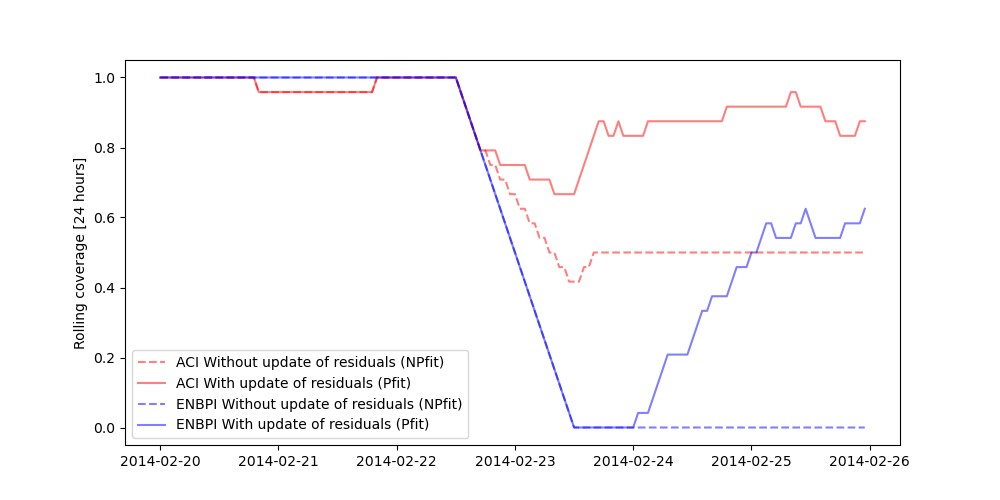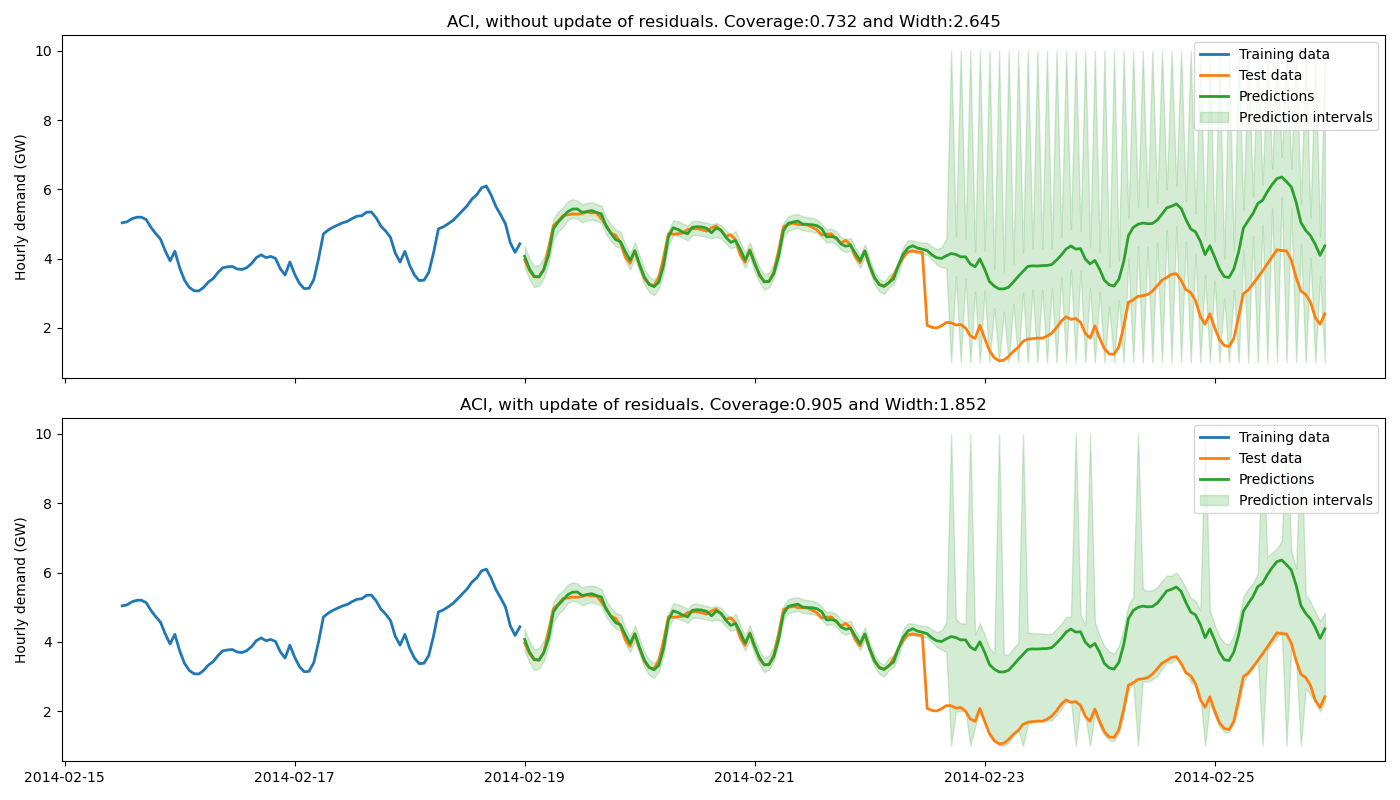Note
Click here to download the full example code
Tutorial for time series¶
In this tutorial we describe how to use
MapieTimeSeriesRegressor
to estimate prediction intervals associated with time series forecast.
Here, we use the Victoria electricity demand dataset used in the book “Forecasting: Principles and Practice” by R. J. Hyndman and G. Athanasopoulos. The electricity demand features daily and weekly seasonalities and is impacted by the temperature, considered here as a exogeneous variable.
Before estimating prediction intervals with MAPIE, we optimize the base model,
here a Random Forest model. The hyper-parameters are
optimized with a RandomizedSearchCV using a
sequential TimeSeriesSplit cross validation,
in which the training set is prior to the validation set.
Once the base model is optimized, we can use
MapieTimeSeriesRegressor to estimate
the prediction intervals associated with one-step ahead forecasts through
the EnbPI method [1].
As its parent class MapieRegressor,
MapieTimeSeriesRegressor has two main arguments : “cv”, and “method”.
In order to implement EnbPI, “method” must be set to “enbpi” (the default
value) while “cv” must be set to the BlockBootstrap
class that block bootstraps the training set.
This sampling method is used in [1] instead of the traditional bootstrap
strategy as it is more suited for time series data.
The EnbPI method allows you update the residuals during the prediction,
each time new observations are available so that the deterioration of
predictions, or the increase of noise level, can be dynamically taken into
account. It can be done with MapieTimeSeriesRegressor through
the partial_fit class method called at every step.
The ACI [2] strategy allows you to adapt the conformal inference (i.e the quantile). If the real values are not in the coverage, the size of the intervals will grow. Conversely, if the real values are in the coverage, the size of the intervals will decrease. You can use a gamma coefficient to adjust the strength of the correction.
References¶
[1] Chen Xu and Yao Xie. “Conformal Prediction Interval for Dynamic Time-Series.” International Conference on Machine Learning (ICML, 2021).
[2] Isaac Gibbs, Emmanuel Candes “Adaptive conformal inference under distribution shift” Advances in Neural Information Processing Systems, (NeurIPS, 2021).
[3] Margaux Zaffran et al. “Adaptive Conformal Predictions for Time Series” https://arxiv.org/pdf/2202.07282.pdf
import warnings
import numpy as np
import pandas as pd
from matplotlib import pylab as plt
from scipy.stats import randint
from sklearn.ensemble import RandomForestRegressor
from sklearn.model_selection import RandomizedSearchCV, TimeSeriesSplit
from mapie.metrics import (coverage_width_based, regression_coverage_score,
regression_mean_width_score)
from mapie.regression import MapieTimeSeriesRegressor
from mapie.subsample import BlockBootstrap
warnings.simplefilter("ignore")
1. Load input data and dataset preparation¶
The Victoria electricity demand dataset can be downloaded directly on the MAPIE github repository. It consists in hourly electricity demand (in GW) of the Victoria state in Australia together with the temperature (in Celsius degrees). We extract temporal features out of the date and hour.
num_test_steps = 24 * 7
url_file = (
"https://raw.githubusercontent.com/scikit-learn-contrib/MAPIE/master/"
"examples/data/demand_temperature.csv"
)
demand_df = pd.read_csv(
url_file, parse_dates=True, index_col=0
)
demand_df["Date"] = pd.to_datetime(demand_df.index)
demand_df["Weekofyear"] = demand_df.Date.dt.isocalendar().week.astype("int64")
demand_df["Weekday"] = demand_df.Date.dt.isocalendar().day.astype("int64")
demand_df["Hour"] = demand_df.index.hour
n_lags = 5
for hour in range(1, n_lags):
demand_df[f"Lag_{hour}"] = demand_df["Demand"].shift(hour)
We now introduce a brutal changepoint in the test set by decreasing the electricity demand by 2 GW on February 22. It aims at simulating an effect, such as blackout or lockdown due to a pandemic, that was not taken into account by the model during its training.
demand_df.Demand.iloc[-int(num_test_steps/2):] -= 2
The last week of the dataset is considered as test set, the remaining data is used as training set.
demand_train = demand_df.iloc[:-num_test_steps, :].copy()
demand_test = demand_df.iloc[-num_test_steps:, :].copy()
features = ["Weekofyear", "Weekday", "Hour", "Temperature"]
features += [f"Lag_{hour}" for hour in range(1, n_lags)]
X_train = demand_train.loc[
~np.any(demand_train[features].isnull(), axis=1), features
]
y_train = demand_train.loc[X_train.index, "Demand"]
X_test = demand_test.loc[:, features]
y_test = demand_test["Demand"]
Let’s now visualize the training and test sets with the changepoint.
plt.figure(figsize=(16, 5))
plt.plot(y_train)
plt.plot(y_test)
plt.ylabel("Hourly demand (GW)")
plt.legend(["Training data", "Test data"])
plt.show()

2. Optimize the base estimator¶
Before estimating the prediction intervals with MAPIE, let’s optimize the
base model, here a RandomForestRegressor through a
RandomizedSearchCV with a temporal cross-validation strategy.
For the sake of computational time, the best parameters are already tuned.
model_params_fit_not_done = False
if model_params_fit_not_done:
# CV parameter search
n_iter = 100
n_splits = 5
tscv = TimeSeriesSplit(n_splits=n_splits)
random_state = 59
rf_model = RandomForestRegressor(random_state=random_state)
rf_params = {"max_depth": randint(2, 30), "n_estimators": randint(10, 100)}
cv_obj = RandomizedSearchCV(
rf_model,
param_distributions=rf_params,
n_iter=n_iter,
cv=tscv,
scoring="neg_root_mean_squared_error",
random_state=random_state,
verbose=0,
n_jobs=-1,
)
cv_obj.fit(X_train, y_train)
model = cv_obj.best_estimator_
else:
# Model: Random Forest previously optimized with a cross-validation
model = RandomForestRegressor(
max_depth=10, n_estimators=50, random_state=59
)
3. Estimate prediction intervals on the test set¶
We now use MapieTimeSeriesRegressor to build prediction intervals
associated with one-step ahead forecasts. As explained in the introduction,
we use the EnbPI method [1] and the ACI method [2] .
Estimating prediction intervals can be possible in three ways:
with a regular
.fitand.predictprocess, limiting the use of trainining set residuals to build prediction intervalsusing
.partial_fitin addition to.fitand.predictallowing MAPIE to use new residuals from the test points as new data are becoming available.using
.partial_fitand.adapt_conformal_inferencein addition to.fitand.predictallowing MAPIE to use new residuals from the test points as new data are becoming available.
The latter method is particularly useful to adjust prediction intervals to sudden change points on test sets that have not been seen by the model during training.
Following [1], we use the BlockBootstrap sampling
method instead of the traditional bootstrap strategy for training the model
since the former is more suited for time series data.
Here, we choose to perform 10 resamplings with 10 blocks.
alpha = 0.05
gap = 1
cv_mapiets = BlockBootstrap(
n_resamplings=10, n_blocks=10, overlapping=False, random_state=59
)
mapie_enbpi = MapieTimeSeriesRegressor(
model, method="enbpi", cv=cv_mapiets, agg_function="mean", n_jobs=-1
)
mapie_aci = MapieTimeSeriesRegressor(
model, method="aci", cv=cv_mapiets, agg_function="mean", n_jobs=-1
)
Let’s start by estimating prediction intervals without partial fit.
# For EnbPI
mapie_enbpi = mapie_enbpi.fit(X_train, y_train)
y_pred_enbpi_npfit, y_pis_enbpi_npfit = mapie_enbpi.predict(
X_test, alpha=alpha, ensemble=True, optimize_beta=True,
allow_infinite_bounds=True
)
y_pis_enbpi_npfit = np.clip(y_pis_enbpi_npfit, 1, 10)
coverage_enbpi_npfit = regression_coverage_score(
y_test, y_pis_enbpi_npfit[:, 0, 0], y_pis_enbpi_npfit[:, 1, 0]
)
width_enbpi_npfit = regression_mean_width_score(
y_pis_enbpi_npfit[:, 0, 0], y_pis_enbpi_npfit[:, 1, 0]
)
cwc_enbpi_npfit = coverage_width_based(
y_test, y_pis_enbpi_npfit[:, 0, 0],
y_pis_enbpi_npfit[:, 1, 0],
eta=10,
alpha=0.05
)
# For ACI
mapie_aci = mapie_aci.fit(X_train, y_train)
y_pred_aci_npfit = np.zeros(y_pred_enbpi_npfit.shape)
y_pis_aci_npfit = np.zeros(y_pis_enbpi_npfit.shape)
y_pred_aci_npfit[:gap], y_pis_aci_npfit[:gap, :, :] = mapie_aci.predict(
X_test.iloc[:gap, :], alpha=alpha, ensemble=True, optimize_beta=True,
allow_infinite_bounds=True
)
for step in range(gap, len(X_test), gap):
mapie_aci.adapt_conformal_inference(
X_test.iloc[(step - gap):step, :].to_numpy(),
y_test.iloc[(step - gap):step].to_numpy(),
gamma=0.05
)
(
y_pred_aci_npfit[step:step + gap],
y_pis_aci_npfit[step:step + gap, :, :],
) = mapie_aci.predict(
X_test.iloc[step:(step + gap), :],
alpha=alpha,
ensemble=True,
optimize_beta=True,
allow_infinite_bounds=True
)
y_pis_aci_npfit[step:step + gap, :, :] = np.clip(
y_pis_aci_npfit[step:step + gap, :, :], 1, 10
)
coverage_aci_npfit = regression_coverage_score(
y_test, y_pis_aci_npfit[:, 0, 0], y_pis_aci_npfit[:, 1, 0]
)
width_aci_npfit = regression_mean_width_score(
y_pis_aci_npfit[:, 0, 0], y_pis_aci_npfit[:, 1, 0]
)
cwc_aci_npfit = coverage_width_based(
y_test,
y_pis_aci_npfit[:, 0, 0],
y_pis_aci_npfit[:, 1, 0],
eta=10,
alpha=0.05
)
Let’s now estimate prediction intervals with partial fit. As discussed previously, the update of the residuals and the one-step ahead predictions are performed sequentially in a loop.
mapie_enbpi = MapieTimeSeriesRegressor(
model, method="enbpi", cv=cv_mapiets, agg_function="mean", n_jobs=-1
)
mapie_enbpi = mapie_enbpi.fit(X_train, y_train)
y_pred_enbpi_pfit = np.zeros(y_pred_enbpi_npfit.shape)
y_pis_enbpi_pfit = np.zeros(y_pis_enbpi_npfit.shape)
y_pred_enbpi_pfit[:gap], y_pis_enbpi_pfit[:gap, :, :] = mapie_enbpi.predict(
X_test.iloc[:gap, :], alpha=alpha, ensemble=True, optimize_beta=True,
allow_infinite_bounds=True
)
for step in range(gap, len(X_test), gap):
mapie_enbpi.partial_fit(
X_test.iloc[(step - gap):step, :],
y_test.iloc[(step - gap):step],
)
(
y_pred_enbpi_pfit[step:step + gap],
y_pis_enbpi_pfit[step:step + gap, :, :],
) = mapie_enbpi.predict(
X_test.iloc[step:(step + gap), :],
alpha=alpha,
ensemble=True,
optimize_beta=True,
allow_infinite_bounds=True
)
y_pis_enbpi_pfit[step:step + gap, :, :] = np.clip(
y_pis_enbpi_pfit[step:step + gap, :, :], 1, 10
)
coverage_enbpi_pfit = regression_coverage_score(
y_test, y_pis_enbpi_pfit[:, 0, 0], y_pis_enbpi_pfit[:, 1, 0]
)
width_enbpi_pfit = regression_mean_width_score(
y_pis_enbpi_pfit[:, 0, 0], y_pis_enbpi_pfit[:, 1, 0]
)
cwc_enbpi_pfit = coverage_width_based(
y_test, y_pis_enbpi_pfit[:, 0, 0], y_pis_enbpi_pfit[:, 1, 0],
eta=10,
alpha=0.05
)
Let’s now estimate prediction intervals with adapt_conformal_inference. As discussed previously, the update of the current alpha and the one-step ahead predictions are performed sequentially in a loop.
mapie_aci = MapieTimeSeriesRegressor(
model, method="aci", cv=cv_mapiets, agg_function="mean", n_jobs=-1
)
mapie_aci = mapie_aci.fit(X_train, y_train)
y_pred_aci_pfit = np.zeros(y_pred_aci_npfit.shape)
y_pis_aci_pfit = np.zeros(y_pis_aci_npfit.shape)
y_pred_aci_pfit[:gap], y_pis_aci_pfit[:gap, :, :] = mapie_aci.predict(
X_test.iloc[:gap, :], alpha=alpha, ensemble=True, optimize_beta=True,
allow_infinite_bounds=True
)
for step in range(gap, len(X_test), gap):
mapie_aci.partial_fit(
X_test.iloc[(step - gap):step, :],
y_test.iloc[(step - gap):step],
)
mapie_aci.adapt_conformal_inference(
X_test.iloc[(step - gap):step, :].to_numpy(),
y_test.iloc[(step - gap):step].to_numpy(),
gamma=0.05
)
(
y_pred_aci_pfit[step:step + gap],
y_pis_aci_pfit[step:step + gap, :, :],
) = mapie_aci.predict(
X_test.iloc[step:(step + gap), :],
alpha=alpha,
ensemble=True,
optimize_beta=True,
allow_infinite_bounds=True
)
y_pis_aci_pfit[step:step + gap, :, :] = np.clip(
y_pis_aci_pfit[step:step + gap, :, :], 1, 10
)
coverage_aci_pfit = regression_coverage_score(
y_test, y_pis_aci_pfit[:, 0, 0], y_pis_aci_pfit[:, 1, 0]
)
width_aci_pfit = regression_mean_width_score(
y_pis_aci_pfit[:, 0, 0], y_pis_aci_pfit[:, 1, 0]
)
cwc_aci_pfit = coverage_width_based(
y_test, y_pis_aci_pfit[:, 0, 0], y_pis_aci_pfit[:, 1, 0],
eta=0.01,
alpha=0.05
)
4. Plot estimated prediction intervals on one-step ahead forecast¶
Let’s now compare the prediction intervals estimated by MAPIE with and without update of the residuals.
y_enbpi_preds = [y_pred_enbpi_npfit, y_pred_enbpi_pfit]
y_enbpi_pis = [y_pis_enbpi_npfit, y_pis_enbpi_pfit]
coverages_enbpi = [coverage_enbpi_npfit, coverage_enbpi_pfit]
widths_enbpi = [width_enbpi_npfit, width_enbpi_pfit]
y_aci_preds = [y_pred_aci_npfit, y_pred_aci_pfit]
y_aci_pis = [y_pis_aci_npfit, y_pis_aci_pfit]
coverages_aci = [coverage_aci_npfit, coverage_aci_pfit]
widths_aci = [width_aci_npfit, width_aci_pfit]
fig, axs = plt.subplots(
nrows=2, ncols=1, figsize=(14, 8), sharey="row", sharex="col"
)
for i, (ax, w) in enumerate(zip(axs, ["without", "with"])):
ax.set_ylabel("Hourly demand (GW)")
ax.plot(
y_train[int(-len(y_test)/2):],
lw=2,
label="Training data", c="C0"
)
ax.plot(y_test, lw=2, label="Test data", c="C1")
ax.plot(
y_test.index, y_enbpi_preds[i], lw=2, c="C2", label="Predictions"
)
ax.fill_between(
y_test.index,
y_enbpi_pis[i][:, 0, 0],
y_enbpi_pis[i][:, 1, 0],
color="C2",
alpha=0.2,
label="Prediction intervals",
)
title = f"EnbPI, {w} update of residuals. "
title += (f"Coverage:{coverages_enbpi[i]:.3f} and "
f"Width:{widths_enbpi[i]:.3f}")
ax.set_title(title)
ax.legend()
fig.tight_layout()
plt.show()
fig, axs = plt.subplots(
nrows=2, ncols=1, figsize=(14, 8), sharey="row", sharex="col"
)
for i, (ax, w) in enumerate(zip(axs, ["without", "with"])):
ax.set_ylabel("Hourly demand (GW)")
ax.plot(
y_train[int(-len(y_test)/2):],
lw=2,
label="Training data", c="C0"
)
ax.plot(y_test, lw=2, label="Test data", c="C1")
ax.plot(
y_test.index, y_aci_preds[i], lw=2, c="C2", label="Predictions"
)
ax.fill_between(
y_test.index,
y_aci_pis[i][:, 0, 0],
y_aci_pis[i][:, 1, 0],
color="C2",
alpha=0.2,
label="Prediction intervals",
)
title = f"ACI, {w} update of residuals. "
title += f"Coverage:{coverages_aci[i]:.3f} and Width:{widths_aci[i]:.3f}"
ax.set_title(title)
ax.legend()
fig.tight_layout()
plt.show()
Let’s now compare the coverages obtained by MAPIE with and without update of the residuals on a 24-hour rolling window of prediction intervals.
rolling_coverage_aci_pfit, rolling_coverage_aci_npfit = [], []
rolling_coverage_enbpi_pfit, rolling_coverage_enbpi_npfit = [], []
window = 24
for i in range(window, len(y_test), 1):
rolling_coverage_aci_npfit.append(
regression_coverage_score(
y_test[i-window:i], y_pis_aci_npfit[i-window:i, 0, 0],
y_pis_aci_npfit[i-window:i, 1, 0]
)
)
rolling_coverage_aci_pfit.append(
regression_coverage_score(
y_test[i-window:i], y_pis_aci_pfit[i-window:i, 0, 0],
y_pis_aci_pfit[i-window:i, 1, 0]
)
)
rolling_coverage_enbpi_npfit.append(
regression_coverage_score(
y_test[i-window:i], y_pis_enbpi_npfit[i-window:i, 0, 0],
y_pis_enbpi_npfit[i-window:i, 1, 0]
)
)
rolling_coverage_enbpi_pfit.append(
regression_coverage_score(
y_test[i-window:i], y_pis_enbpi_pfit[i-window:i, 0, 0],
y_pis_enbpi_pfit[i-window:i, 1, 0]
)
)
plt.figure(figsize=(10, 5))
plt.ylabel(f"Rolling coverage [{window} hours]")
plt.plot(
y_test[window:].index,
rolling_coverage_aci_npfit,
label="ACI Without update of residuals (NPfit)",
linestyle='--', color='r', alpha=0.5
)
plt.plot(
y_test[window:].index,
rolling_coverage_aci_pfit,
label="ACI With update of residuals (Pfit)",
linestyle='-', color='r', alpha=0.5
)
plt.plot(
y_test[window:].index,
rolling_coverage_enbpi_npfit,
label="ENBPI Without update of residuals (NPfit)",
linestyle='--', color='b', alpha=0.5
)
plt.plot(
y_test[window:].index,
rolling_coverage_enbpi_pfit,
label="ENBPI With update of residuals (Pfit)",
linestyle='-', color='b', alpha=0.5
)
plt.legend()
plt.show()

The training data do not contain a change point, hence the base model cannot anticipate it. Without update of the residuals, the prediction intervals are built upon the distribution of the residuals of the training set. Therefore they do not cover the true observations after the change point, leading to a sudden decrease of the coverage. However, the partial update of the residuals allows the method to capture the increase of uncertainties of the model predictions. One can notice that the uncertainty’s explosion happens about one day late. This is because enough new residuals are needed to change the quantiles obtained from the residuals distribution.
Total running time of the script: ( 2 minutes 31.075 seconds)

